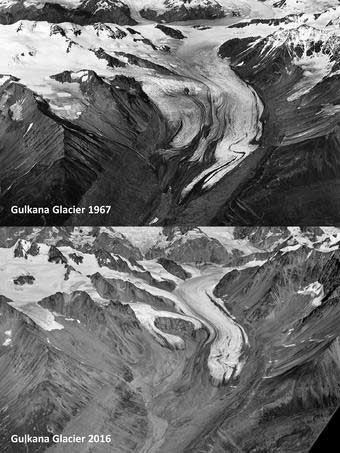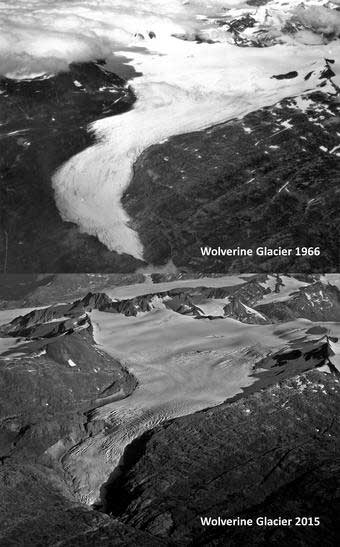
Fifty Years of Glacier Change Research in Alaska
September 29, 2016
In 1966, the U.S. Geological Survey began measuring changes in mass and volume at Wolverine and Gulkana glaciers in Alaska as part of its Benchmark Glacier program. These data serve as indicators of glacier health and help scientists understand how glaciers respond to a warming climate. “Collectively, Alaska’s glaciers are shrinking rapidly today. Long-term records from Wolverine and Gulkana glaciers show that summer warming has resulted in sustained mass loss. These changes are evident in both field and in airborne and space-borne data. Alaska’s glaciers are important contributors to sea level rise, and also influence coastal ecosystems through the water that they store and release,” said Dr. Shad O’Neel, head of the Glacier Research Program at the USGS Alaska Science Center. Since the 1990s, the retreat of glaciers in Alaska has made a disproportionally large contribution to global sea level rise. In total, these glaciers are losing 75 billion tons of ice annually, the equivalent of filling 150,000 Yankee Stadiums with water each year. Although the development of regional estimates is relatively new, the detailed and long-term records at the benchmark glaciers reveal an increasing rate of change through the past 50 years. “These records are a testament to the hard work of many individuals and an early vision by USGS on the importance of glaciers in the landscape,” said Daniel McGrath, a research geophysicist with the program. “Detailed and continuous records of this length are exceedingly rare in our field and thus these are indispensable to our understanding of the changes we’re observing across this region.” The glaciers and ice fields of Alaska are responsible for nearly 50 percent of the water that flows into the Gulf of Alaska. This water has a unique “glacial fingerprint” that is evident in the timing, volume and temperature, as well as the nutrients carried by it. This influence also extends to the marine ecosystem, contributing to the rich diversity of species that are important to tourism and fishing industries. To accomplish this work, USGS scientists travel to Wolverine and Gulkana glaciers twice a year to make observations of snow accumulation and snow/ice melt that allow them to calculate the health of the glaciers. These measurements allow scientists to resolve changes in glacier size through time, and demonstrate sustained and continuous mass losses since about 1990. In addition to this work, the team is currently focused on measuring regional change with geophysical and remote sensing methods, and modeling how glaciers will respond to future climate scenarios. Predicted summer warming of 2 to 4 degrees C (3.6 to 7.2 degrees F) and a marked decrease in snow accumulation will contribute to the loss of many thousands of glaciers in Alaska and northwest Canada by the end of the century. By coordinating with landscape ecologists, biologists and oceanographers, the team is assessing how socio-economically important species like salmon are likely to fare in the warmer Alaska of the future. In addition to the work in Alaska, the USGS Benchmark Glacier program also includes South Cascade Glacier in Washington State and Sperry Glacier in Montana. Each of these glaciers are influenced by different climates allowing scientists to compare how glaciers respond in different regions. The Benchmark Glacier data are available online.
On the Web:
Editing by Mary Kauffman, SitNews
Source of News:
Representations of fact and opinions in comments posted are solely those of the individual posters and do not represent the opinions of Sitnews.
|
|||

